Museum of Iron
Coalbrookdale, Ironbridge, Shropshire
|

Location Guide |
"A part of
the World Heritage Site Ironbridge Gorge"
The museum of iron celebrates the importance of
Iron in this gorge and it's effect on the early iron industry. Coalbrookdale was
Abraham Darby's ironworks within the valley. In 1707 he patented a method of
casting iron pots which was to make iron pots to become more accessible to the
ordinary person, and because they were thinner than what had been produced up to
now they were more practical to use. Some would say they were not pretty, being
black and not very decorative, but they were practical and useable and became
very popular. Over successive generations of the family the factory
expanded into producing iron wheels, rails, steam engine cylinders, and bridges
like that at Ironbridge itself. By the Victorian period it had become famous for
it's decorative cast ironwork.
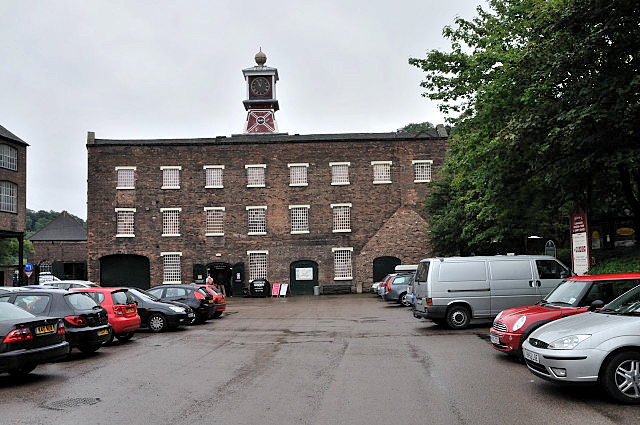 
Abraham Darby pioneered the smelting techniques
which produce cast iron and he not only revolutionised the iron industry but
also transformed the home making cooking much easier with cooking pots initially
and then branching out into mangles, fireplaces, lamp holders, hat stands and
more.
| Today the Coalbrookdale factory is a museum and
as you enter the museum you are taken on a journey through the history of iron,
finding out about the people behind the factory and Iron making, as well as
seeing many examples of what cast iron can be used for as well as how decorative
it can be. Over 3 floors it contains many exhibits and examples of what can be
achieved with cast iron. Amongst the exhibits are many cast iron pots in
different sizes and styles, there is a large deerhound round hall table made of
iron and the 4 life size deerhounds support the large and what looks to be heavy
marble tabletop, however it is painted to look like marble. One thing you will
notice is the versatility of iron being used for aesthetic purposes, it can be
sculpted and there are many sculptures of dogs, deer and some of them life-size,
and into more practical items such as hall tables, garden furniture, fire
grates, kitchen ranges and Rayburns/Aga's of differing generations including up
to date new ones which are still made in the area today. On the first floor of the museum you are first
shown the difference between cast-iron and wrought-iron being taken through the
different techniques used of how it is made as well as examples of what can be
achieved with each, such as the intricate wrought iron items, like railings that
could be achieved by the blacksmith and the more solid art objects which are
made of the lighter weight cast iron. There are exhibits that allow you get
hands on to see how some of the processes work, as well as those that show you
what can be achieved with the cast iron process.
 |
 |
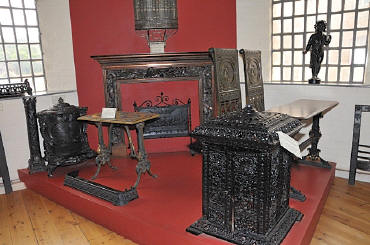 |
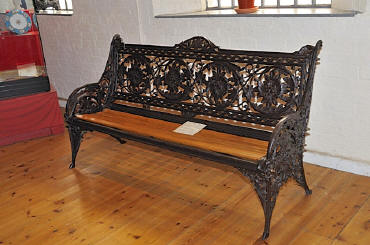 |
  Examples of some of the decorative work
Examples of some of the decorative work
  |
| On the second floor this looks at Coalbrookdale,
both the company, the community and the Darby family. It takes you through the
different people who had a influence on the company and area, not only the
Darby's but others that were brought in to manage it. Exhibits, films,
quotations from famous customers such as Richard Trevethick, the Cornish
engineer, and examples of goods and products. On top of the museum building is a large
clocktower made of cast iron, which has intricate panels that show off the skill
and craftsmanship of those working at the factory at that time.
Within the grounds there are the remains of
some of the ironworks and in a new wooden building to protect it the remains of
Abraham Darby's original Old Furnace. From the viewing platform you get to take
a look down into the old furnace, this is the position the workers would have
experienced the intense heat and choking fumes as they tipped the raw materials
from their baskets into the opening. During the main tourist season guided tours
take place so as you take a look at both the remaining walls of the furnace area
and into the Old Furnace building you find out about the history of the place
and how it might have run at that time. Outside there are also some ironwork
statues. The grounds are also overlooked by the large arches of the Severn
Valley Railway branch line, which is still in use today carrying goods only, no
passenger service.
The Clock Tower
 |
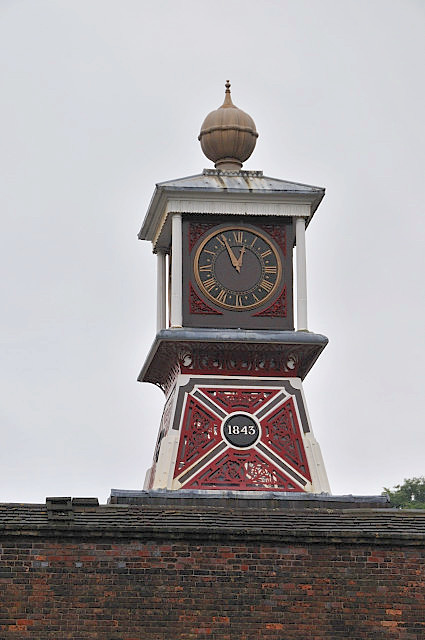 |
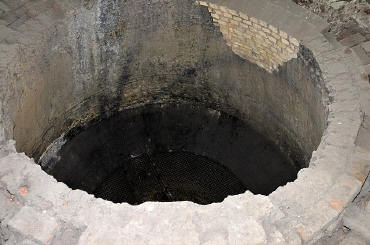 |
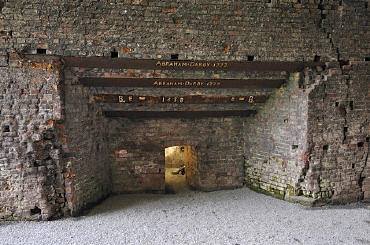 |

 The Old Furnace from the top
The Old Furnace from the top |

 The Old Furnaces from below
The Old Furnaces from below |
Nearby are the
Darby
Houses,
 which were homes of the Darby family during their time at the factory. These
houses overlook the top-up pond which provided the water needed to power the
bellows on the furnace. Behind the main museum building another building as been
transformed into another museum,
Enginuity,
which were homes of the Darby family during their time at the factory. These
houses overlook the top-up pond which provided the water needed to power the
bellows on the furnace. Behind the main museum building another building as been
transformed into another museum,
Enginuity,
 which is worth taking a look at, and kids will really enjoy the hands on
experience they get in here.
which is worth taking a look at, and kids will really enjoy the hands on
experience they get in here.
The Annual Passport.
The Ironbridge Museums
operate an Annual Ticket and Passport where for one price you can get access to
all 10 of their sites with unlimited day time access during normal opening
hours, so you can return as often as you like for a whole year. If after
12 months you have still not visited particular sites, you can return at any
time in the future to make one free visit to the sites that you've missed. These
tickets are sold at all the museums and the visitor information centre in Ironbridge itself or you can buy them in advance by phone. The
2009 prices for the Passport tickets are: Adult
£19.95; 60+ £15.95; Child £12.95 or a family ticket for 2A up to
3C £54.95.
Please let us know any other information that we
can add to the Grid(s) or page and any errors that you discover. Before making a long trip to any location it is always
wise to double check the current information, websites like magazines may be
correct at the time the information is written, but things change and it is of
course impossible to double check all entries on a regular basis. If you have
any good photographs that you feel would improve the illustration of this page
then please let us have copies. In referring to this page it is helpful if you
quote both the Page Ref and Topic or Section references from the Grid below. To print the
planning grid select it then right click and print the selected area.
Please submit information on locations you discover so
that this system continues to grow.
|